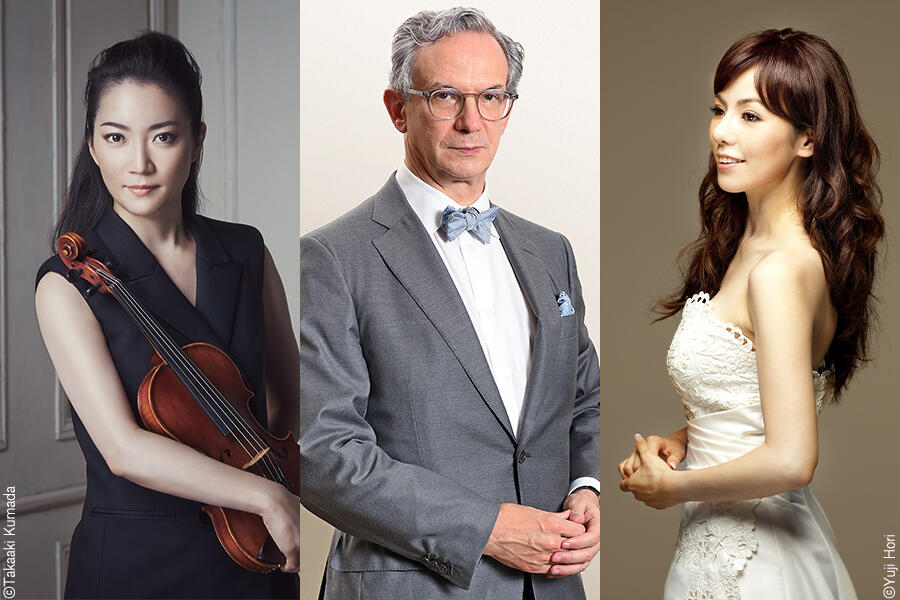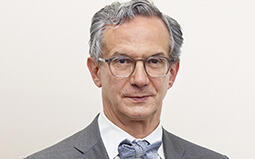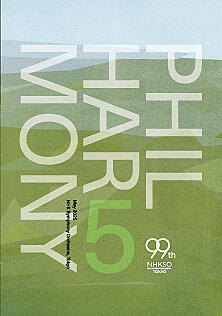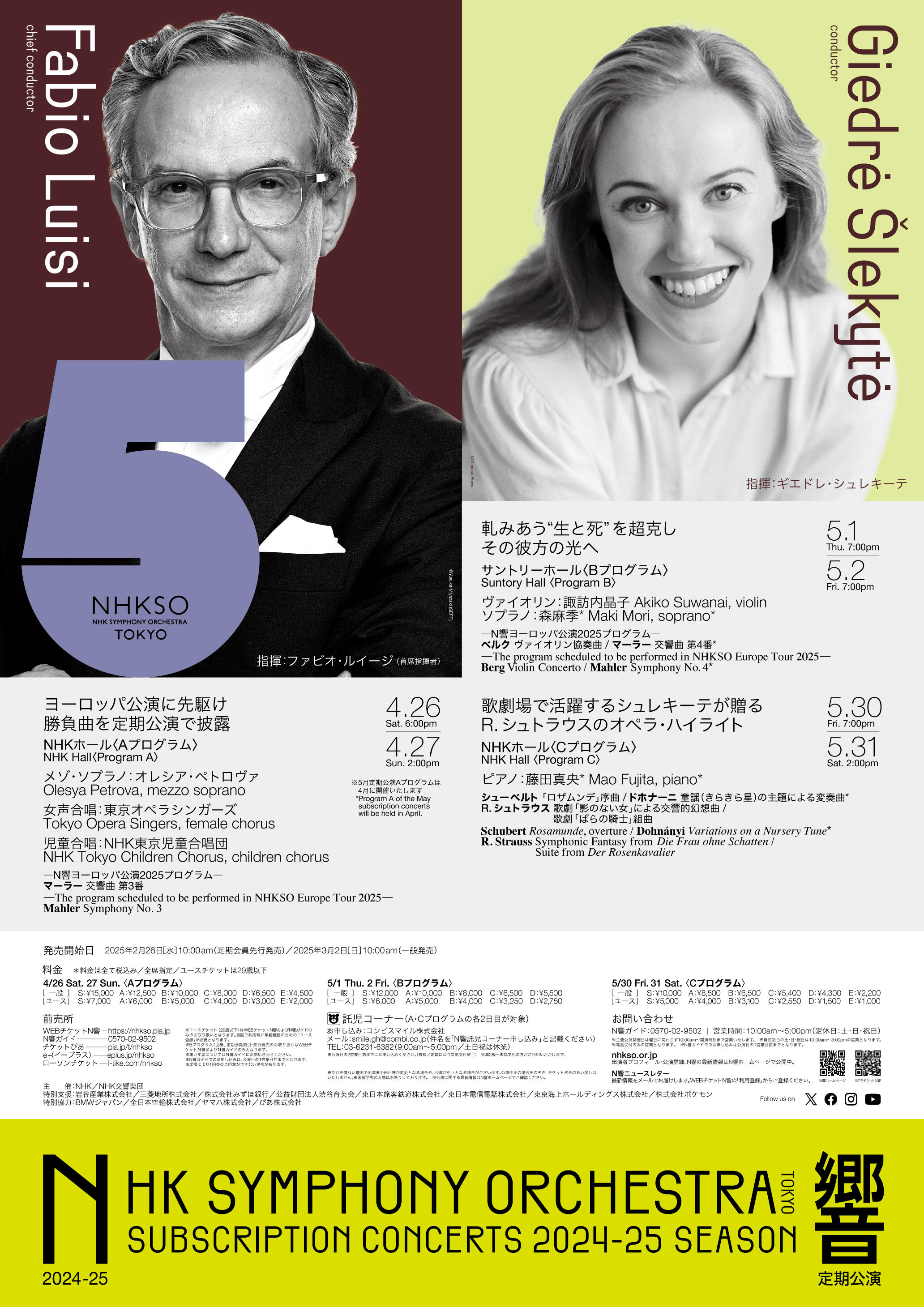- Home
- Concerts
- Subscription Concerts 2024-2025
- Program B
- No. 2037 Subscription (Program B)
Subscription Concerts 2024-2025Program B
No. 2037 Subscription (Program B)

Program
- The Program Scheduled to be Performed in NHKSO Europe Tour 2025 -
Berg / Violin Concerto
Vienna remained a capital of music throughout the 19th century ever since Joseph Haydn (1732–1809) established the First Viennese School. At the turn of the next century, the City of Music witnessed a major shift from the late-Romanticism culminating with Gustav Mahler (described later) to the modernistic Second Viennese School initiated by Arnold Schönberg (1874–1951).
The Vienna-born composer Alban Berg (1885–1935), one of Schönberg’s two devoted disciples alongside Anton Webern (1883–1945), followed his teacher’s stylistic evolutions. They developed an atonal language free from any major/minor key, before Schönberg fully established the twelve-tone technique in 1921. The technique of treating all the twelve notes of an octave equally meant the dissolution of the hierarchy of the keys and notes. However, Berg adopted this novel technique less strictly than Webern and often revealed nostalgia for tonality in his works.
Composed during a single sitting in 1935, the Violin Concerto is the last piece Berg completed before he untimely passed away at the end of the same year. The dedication “To the memory of an angel” refers to Manon Gropius (1916–1935), the daughter of the architect Walter Gropius and Alma Mahler-Werfel (the widow of Mahler). Berg felt deep sorrow at the early death by polio of Manon whom he and his wife had treated like their own child.
The first movement, portraying Manon during her life, consists of two sections (Andante 4/4 – Allegretto 6/8). Andante is opened by clarinets, a harp and the violin solo introducing the twelve-tone row that the concerto is based on (G–B♭–D–F♯–A–C–E–G♯–B–C♯–E♭–F). Famously abundant in tonal elements, this row sounds Romantic at times. Light-hearted, Allegretto has a symmetric structure (Scherzo–Trio1–Trio2–Trio1–Scherzo).
The second movement, describing Manon’s mortal suffering and ascension to heaven, is also divided into two sections (Allegro 3/4–Adagio 4/4). To start Adagio, the violin solo calmly quotes the chorale Es ist genug (It is Enough) from J. S. Bach’s cantata O Ewigkeit, du Donnerwort (O Eternity, Thou Word of Thunder) BWV60, which is followed by variations on this melody.
[Kumiko Nishi]
Mahler / Symphony No. 4 G Major*
In 1930, the NHK Symphony Orchestra (then the New Symphony Orchestra of Tokyo) under the baton of its founder Hidemaro Konoe made history recording Gustav Mahler (1860–1911)’s Symphony No. 4 for the first time in the world. Worth noting in particular is that the orchestra led by its Chief Conductor Fabio Luisi will soon perform No. 4 (and No. 3) debuting at Amsterdam’s renowned Mahler Festival as the first Asian orchestra.
Mahler’s No. 2 (1894), No. 3 (1896) and No. 4 (1900) are collectively known as the Wunderhorn (Magic Horn) Symphonies, for the three works are inextricably bound up with the composer’s own song series Des Knaben Wunderhorn (The Boy’s Magic Horn). Mentioning the sisterhood of No. 3 and No. 4 is especially unavoidable, because the finale of No. 4 was supposed to be the closing seventh movement (initially entitled “What the Child Tells Me”) of No. 3. This salvaged movement is actually the rework of Mahler’s song for voice and orchestra “Das himmlische Leben (Heavenly Life)”(1892) that he once included in the Wunderhorn song series.
Mahler was at the peak of his conducting career when he composed No. 4. The Jewish musician was converted to Roman Catholicism in 1897 right before the prestigious Vienna Court Opera appointed him Kapellmeister (later Director), posts that Mahler had long dreamed of. From 1898 on, he would be concurrently in charge of the direction of the Vienna Philharmonic Orchestra’s subscription concerts. Mahler a.k.a. The Summer Composer set to work on No. 4 (starting with the above-mentioned final movement) during the 1899 summer break at the Austrian spa town Altaussee and completed it the next summer at the Austrian lakeside resort Maiernigg. He would keep revising it before and even after the 1901 premiere in Munich.
Unlike the six-movement long and massive No. 3, the four-movement compact No. 4 calls for a relatively small orchestra (without tuba and trombone). The first movement, a G-major sonata, is opened by flutes and leigh bells. These apparently naive but meaningful bells will play a vital role at the final “Heavenly Life / What the Child Tells Me” movement where the soprano solo sings about the joy of heaven (“We wallow in heavenly pleasures” … “No worldly tumult is heard in heaven” … “Delicious apples, delicious pears and delicious grapes! The gardeners allow everything”... “There’s no music on earth that can compare with ours”). In this pseudoclassical or neoclassical symphony, Mahler’s parodic spirit is the most discernible in the eerie second movement. This scherzo in C minor lets the concertmaster play on a violin tuned a whole note higher (A–E–B–F♯) while other orchestral violins are tuned normally (G–D–A–E). This dance macabre (dance of death) is to portray, according to Mahler’s own words, “Freud Hein (Death) performing his fiddle.”
[Kumiko Nishi]
Artists
 ConductorFabio Luisi
ConductorFabio Luisi
Fabio Luisi hails from Genoa. He is the Principal Conductor of the Danish National Symphony Orchestra and the Music Director of the Dallas Symphony Orchestra. He first conducted the NHK Symphony Orchestra in 2001, and in September 2022 he became Chief Conductor of the orchestra. He conducted Verdi’s Requiem in the concert to celebrate his appointment, and Mahler’s Symphonie der Tausend to commemorate the orchestra’s 2000th subscription concert in December 2023. These two monumental performances have brought him great success. He has presented works of German and Austrian composers such as Beethoven, Brahms, Bruckner and R. Strauss as well as those of Franck and Saint-Saëns, Francophone composers, and with his conducting style full of passion and poetic sentiment, has captured the hearts of many of audience members. In August 2024, he led the orchestra’s Taiwanese tour, and then will also lead a European tour in May 2025, which has been scheduled in conjunction with the Mahler Festival at The Concertgebouw, Amsterdam, the Prague Spring Festival and the Dresdner Musikfestspiele to which the NHK Symphony Orchestra has been invited.
He was General Music Director of the Opernhaus Zürich, Principal Conductor of the Metropolitan Opera in New York, Principal Conductor of the Wiener Symphoniker, as well as General Music Director of the Staatskapelle Dresden and the Sächsische Staatsoper, Artistic Director and Principal Conductor of the MDR Sinfonieorchester Leipzig, Music Director of the Orchestre de la Suisse Romande and Chief Conductor of the Tonkünstler Orchester. He is Music Director of the Festival della Valle d’Itria in Martina Franca (Apulia) and has appeared as guest conductor with numerous renowned ensembles, including the Philadelphia Orchestra, the Cleveland Orchestra, the Münchener Philharmoniker, the Filarmonica della Scala, the London Symphony Orchestra, the Royal Concertgebouw Orchestra, and the Saito Kinen Orchestra, while also conducting operas at world’s major opera houses. Important recordings include Verdi, Bellini, Schumann, Berlioz, Rachmaninov, Rimsky-Korsakov, Frank Martin, and Franz Schmidt, the largely forgotten Austrian composer. In addition, he has recorded various symphonic poems by Richard Strauss, and a lauded reading of Bruckner’s Symphony No. 9 with the Staatskapelle Dresden. His recordings of Wagner’s Siegfried and Götterdämmerung with the Metropolitan Opera won Grammy awards. In May 2025, Bruckner’s Symphony No. 8 (1st version), which is his first CD with the NHK Symphony Orchestra, will be released.
 ViolinAkiko Suwanai
ViolinAkiko Suwanai
After becoming the youngest winner of the Tchaikovsky International Competition in 1990, Akiko Suwanai has continued to make successful performances worldwide. She learned under the tutelage of Toshiya Eto, and studied at the Soloist Diploma Course of Toho Gakuen School of Music, the Juilliard School, Columbia University and the Berlin University of the Arts. In addition to her performing career, she founded the International Music Festival NIPPON in 2012, and as its Artistic Director, has held concerts and master classes in Tokyo, Aichi as well as in cities in northern Japan.
Her first appearance with the NHK Symphony Orchestra in its subscription concert was in November 1991, and she performed Bruch’s Violin Concerto No. 1 under the baton of Tadaaki Otaka. In the International Music Festival NIPPON in February 2022, she played Dutilleux’s Nocturne for Violin and Orchestra Sur le même accord and Brahms’ Violin Concerto with the NHK Symphony Orchestra under Otaka’s baton, which was well received.
In the coming performance, she will perform Berg’s Violin Concerto, which she is also to perform in three cities in the subsequent European tour of the orchestra. Her performance with her beloved violin, the Guarneri del Gesu ‘Charles Reade’ made in 1732 (on long-term loan from Dr. Ryuji Ueno), which has both luster and strength, she will surely deliver a transient yet aesthetic sound to the audience.
[Kotaro Yamazaki, music critic]
 Soprano*Maki Mori
Soprano*Maki Mori
Maki Mori is a soprano with a high and clear voice and coloratura singing technique. She studied at Tokyo University of the Arts and its postgraduate course, as well as in Milan and Munich, and has won top prizes at home and abroad, including the Plácido Domingo World Opera Competition “Operalia.”
In 1998, she was the first Japanese to appear at the Washington National Opera in the United States singing in Die Entführung aus dem Serail. She has continuously appeared at opera house in the U.S. as well as Europe, while also performing in many opera productions in Japan, singing roles including Violetta in La Traviata, as well as recitals and concerts nationwide. She is also popularly known for the main theme music for NHK television’s special drama titled Saka no Ue no Kumo (Clouds above the Hill).
Her first collaboration with the NHK Symphony Orchestra in its subscription concert was in May 2000 when she appeared as soloist to sing Mozart’s motette of Exsultate, Jubilate under the baton of David Robertson. Since then, she has often appeared with the orchestra singing Mozart Requiem and Beethoven’s Symphony No. 9 Choral.
The soprano in the final movement of Mahler’s Symphony No. 4 is singing of a happy life in heaven in a light and lovely way, so it will suit her perfectly.
[Kotaro Yamazaki, music critic]
Download
Ticket
Program B
No. 2037 Subscription (Program B)
Suntory Hall
Google Map
Seating Chart
Single Tickets Release Date
Pre-sales for Subscribers:Wednesday, February 26, 2025
*about subscribers
Sale to General Public:Sunday, March 2, 2025
Price
| S | A | B | C | D | |
|---|---|---|---|---|---|
| Ordinary Ticket | 12,000 | 10,000 | 8,000 | 6,500 | 5,500 |
| Youth Ticket | 6,000 | 5,000 | 4,000 | 3,250 | 2,750 |
Seating chart Enlarge Print PDF
*tax included
*Subscribers receive a 10% discount (Available at NHKSO WEB Ticket and N-Kyo Guide)
*For wheelchair-accessible seats, please refer to the N-Kyo Guide
Youth Tickets
Youth Tickets are great options for those of 29 years old and younger
Subscription tickets
Release Date
ANNUAL SUBSCRIPTION TICKETS
Mon., July 15, 2024 10:00am
[For Subscribers: Sun., July 7, 2024 10:00am]
Where to buy
NHKSO WEB Ticket | Thursday, May 1, 2025 (In English / Seats not selectable)
NHKSO WEB Ticket | Friday, May 2, 2025 (In English / Seats not selectable)
NHKSO WEB Ticket (In Japanese only / Seats selectable)
N-Kyo Guide (Purchase by telephone only)
*Repertoire, conductor, soloists and program order are subject to change without notice.
*Pre-school children are not allowed in the concert hall



